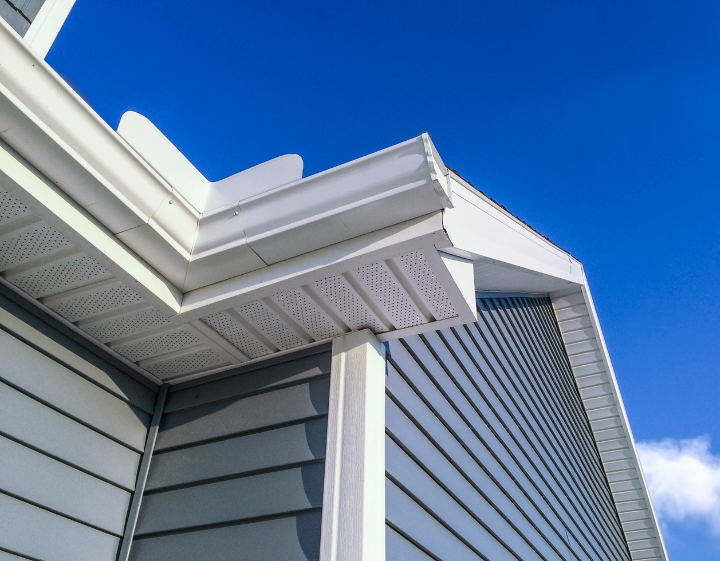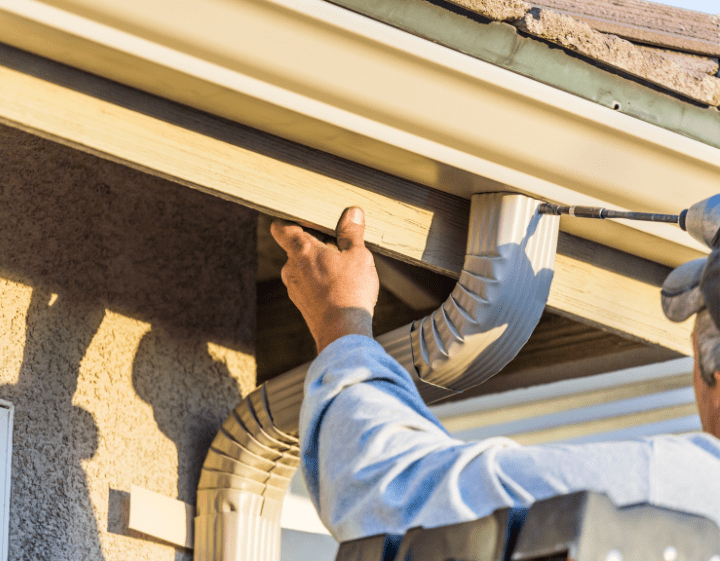Introduction
Gutters may seem like a relatively minor part of our homes, but they actually play a critical role in protecting the structure from water damage. By efficiently redirecting rainwater away from our homes, gutters prevent damage to the foundation, walls, and roof. However, over time, gutters can become damaged, clogged, or simply wear out, requiring replacement to maintain their effectiveness.
This guide aims to empower homeowners with the necessary knowledge for effective gutter replacement. We believe that well-informed decisions are key to maintaining and preserving our homes. By understanding the process of gutter replacement, homeowners can make informed choices about their home maintenance needs, ensuring the long-term protection and structural integrity of their properties.
Throughout this guide, we will cover various aspects of gutter replacement, including selecting the right materials, understanding the different gutter styles and shapes available, and finding reputable vendors or contractors. Furthermore, we will provide insights into the installation process and offer tips for avoiding common pitfalls. Armed with this information, homeowners can confidently navigate the world of gutter replacement, making informed decisions that will benefit their homes for years to come.

Understanding Your Gutter System
Gutters play a vital role in protecting your home from water damage and maintaining its structural integrity. By diverting rainwater away from the foundation, walls, and landscaping, gutters help prevent erosion, basement flooding, and damage to the exterior of your home. Therefore, it is important to have a good understanding of your gutter system and its components.
Gutters are typically made from materials such as aluminum, vinyl, steel, or copper. Each material has its own benefits and drawbacks. Aluminum gutters are lightweight, rust-resistant, and easy to maintain. Vinyl gutters are affordable, lightweight, and resistant to corrosion. Steel gutters are durable and can withstand extreme weather conditions. Copper gutters offer an elegant and timeless aesthetic, though they are more expensive.
There are also different styles of gutters to choose from. K-style gutters have a flat bottom and a decorative appearance, suitable for most homes. Half-round gutters have a rounded shape, which provides a classic look and can handle heavier rainfall. Each style has its own advantages in terms of function and aesthetic appeal.
Understanding the basics of gutter functionality, as well as the common types of gutters available, will help you make informed decisions when it comes to gutter replacement. By considering the material, style, and benefits of various gutter options, you can ensure that your gutter system effectively protects your home.
Signs You Need Gutter Replacement
Gutters are an essential component of any home’s drainage system, directing rainwater away from the foundation and preventing water damage. However, over time, gutters can deteriorate and become less effective. If you notice any of the following signs, it may be time for gutter replacement.
Visible damage is a common indication that gutter replacement is necessary. Cracks, holes, or rust spots can lead to leaking, causing water to overflow and potentially damage the siding or foundation. In addition, if you notice that your gutters are sagging or separating from the house, it indicates potential failure points where water can seep through.
Water damage marks on the siding or beneath the gutters are another clear sign that your gutters are not functioning properly. Staining or marks indicate overflow or leaks that can lead to further water damage if not addressed.
Poor drainage is also a key symptom that your gutters need replacement. If water is not flowing properly or if you notice pooling in the gutters, it suggests blockages or an improper slope. This can lead to water overflowing, potentially causing foundation damage or basement flooding.
By recognizing these signs and promptly addressing them, homeowners can prevent further damage to their homes. A professional assessment can provide homeowners with the necessary information to make informed decisions regarding their gutter replacement needs.
Planning Your Gutter Replacement
When planning your gutter replacement, it is important to carefully assess your current gutter system’s performance and shortcomings. This involves evaluating its ability to effectively channel rainwater away from your home and identifying any signs of damage or wear. Look for leaks, rust, sagging, or excessive clogging that may indicate the need for replacement.
Next, consider the different materials available for gutter installation. Each material has its own pros and cons in terms of durability, maintenance requirements, cost, and aesthetics. Common materials include aluminum, vinyl, and steel. Aluminum is lightweight, resistant to rust, and often affordable, while vinyl is low-maintenance and cost-effective. Steel, on the other hand, offers superior strength and durability, but is more expensive.
Sizing considerations are also vital when planning your gutter replacement. Determine the appropriate size and capacity needed for your new gutters based on your roof size and the local rainfall intensity. Larger roofs or regions with heavy rainfall may require gutters with a larger capacity to effectively handle the water runoff.
By carefully considering these factors and educating yourself about the gutter replacement process, you can make informed decisions regarding your home maintenance needs and ensure that your new gutter system will effectively protect your home from water damage.
Choosing the Right Gutter System
Choosing the right gutter system for your home is crucial for both aesthetic appeal and long-term functionality. When considering gutter replacement, there are several key factors to keep in mind.
One important consideration is the balance between cost and quality. While it is tempting to opt for the least expensive option, investing in higher-quality materials can result in long-term savings. Lesser-quality gutters may require more frequent repairs or replacement, costing you more in the long run. Therefore, it is essential to weigh your budget constraints against the benefits of durable and reliable gutter materials.
Another aspect to consider is the aesthetic compatibility of the gutters with your home’s exterior design. Choose gutters that harmonize with your house’s architectural style and enhance its curb appeal. Various materials, colors, and profiles are available to suit different home designs, ensuring a seamless integration of the gutter system into your overall aesthetic.
Innovative features should also be taken into account when selecting a gutter system. Options such as built-in leaf guards or seamless gutters can offer long-term benefits. Built-in leaf guards help to prevent debris buildup, reducing the need for frequent cleaning and improving the gutter’s overall functionality. Seamless gutters, on the other hand, eliminate seams that can eventually lead to leaks or clogs, ensuring a more efficient gutter system.
Considering these factors will guide you in choosing the right gutter system for your home, balancing cost and quality, enhancing your home’s exterior design, and taking advantage of innovative features that provide long-term benefits.
The Installation Process
The installation process of gutter replacement involves several steps that are best carried out by professionals to ensure a seamless and effective result.
First, the old gutters need to be removed. This requires careful detachment of the existing gutter system, including the downspouts. The old gutters are taken down and disposed of appropriately.
Next, the new gutters are measured, cut, and prepared for installation. The professionals will ensure that the gutters fit perfectly and are aligned correctly to maximize their functionality.
Once the new gutters are ready, they are fastened securely to the fascia board or roofline of the house. The professionals will use durable and reliable fasteners to guarantee stability and longevity.
Downspouts are then attached to the gutters, ensuring proper drainage and water flow. The professionals will position the downspouts strategically to direct water away from the foundation of the house, preventing water damage and structural issues.
Finally, a thorough inspection is conducted to ensure the gutters are installed correctly and are functioning optimally. Any necessary adjustments or repairs are made to guarantee a perfect fit and functionality.
Overall, the installation process of gutter replacement may take a few hours to a couple of days, depending on the size of the property and complexity of the gutter system. Hiring professionals for this process ensures efficient, reliable, and long-lasting results.

Maintenance Tips for Your New Gutters
Regular cleaning and inspection are vital to maximizing the lifespan of newly replaced gutters. Homeowners should schedule routine cleaning at least twice a year, ideally in the spring and fall, to remove debris and prevent clogs. A gutter cleaning tool or pressure washer can be used to clear out leaves, twigs, and other debris. Regular inspection allows homeowners to identify any potential problems early on, such as loose or damaged sections, and take action promptly.
Addressing common gutter issues can prevent the need for another replacement. Clogs can often be cleared using a plumbers’ snake or by flushing the gutters with water. Minor leaks can be sealed with gutter sealant or a patch kit. It is important to address these issues promptly before they worsen and cause further damage to the gutters or the house.
By following these maintenance tips, homeowners can proactively care for their new gutters and prevent costly repairs or replacements down the line. Regular cleaning and inspections, along with prompt attention to minor issues, will ensure the longevity and effectiveness of the gutter system, allowing homeowners to protect their home investment for years to come.
Conclusion
Homeowners must recognize the significance of choosing the right gutter system and professional installation for their homes. It is essential to understand that gutters play a crucial role in protecting the overall structure of the house from water damage. By taking proactive steps in assessing and updating their gutter systems, homeowners can ensure the long-term protection of their property.
Through this guide, we have provided homeowners with the necessary information to make informed decisions regarding gutter replacement. By considering factors such as materials, styles, and sizes, homeowners can select the most suitable gutter system for their specific needs. Moreover, we have emphasized the importance of hiring a professional to ensure proper installation, as this can significantly impact the performance and durability of the gutters.
Ultimately, investing in a high-quality gutter system and professional installation is a critical aspect of home maintenance. By doing so, homeowners can mitigate potential water damage, prevent costly repairs, and maintain the overall integrity of their homes. So, don’t ignore your gutters – take action today and safeguard your home for the future.
